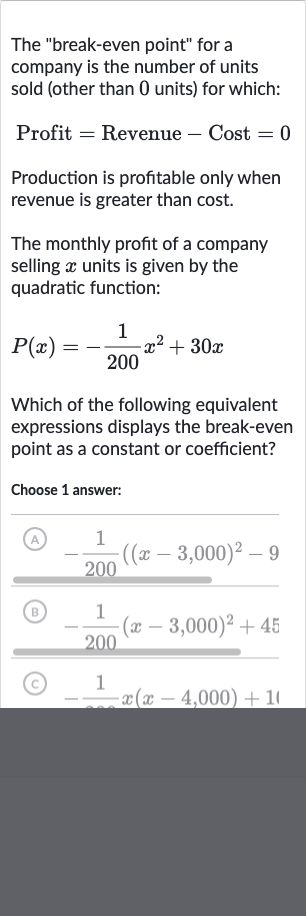AI tutor
Full solution
Q. The
- Profit function and break-even points: We are given the profit function . To find the break-even points, we need to set to zero and solve for .
- Factoring out and solving the quadratic equation: To solve the quadratic equation, we can factor out :
- Finding the break-even point other than units: We now have two solutions for when we set each factor equal to zero: or Since we are looking for the break-even point other than units, we will solve the second equation:
- Solving for x and determining the correct expression: Multiply both sides by to get rid of the fraction:
- Checking the options and evaluating the expressions: Add to both sides to solve for :This is the break-even point, but we need to find which equivalent expression shows this as a constant or coefficient.
- Checking the options and evaluating the expressions: Add to both sides to solve for :This is the break-even point, but we need to find which equivalent expression shows this as a constant or coefficient. Let's examine the choices given:(A) (B) (C) We need to find which one of these, when set equal to zero, will give us as a solution.
- Checking the options and evaluating the expressions: Add to both sides to solve for :This is the break-even point, but we need to find which equivalent expression shows this as a constant or coefficient. Let's examine the choices given:(A) (B) (C) We need to find which one of these, when set equal to zero, will give us as a solution. Let's check option (A):If we expand this, we will not get the original quadratic equation we started with, so this cannot be the correct expression.
- Checking the options and evaluating the expressions: Add to both sides to solve for :This is the break-even point, but we need to find which equivalent expression shows this as a constant or coefficient. Let's examine the choices given:(A) (B) (C) We need to find which one of these, when set equal to zero, will give us as a solution. Let's check option (A):If we expand this, we will not get the original quadratic equation we started with, so this cannot be the correct expression. Let's check option (B):If we multiply by and set it equal to zero, we get:This does not give us as a solution, so this is not the correct expression.
- Checking the options and evaluating the expressions: Add to both sides to solve for :This is the break-even point, but we need to find which equivalent expression shows this as a constant or coefficient. Let's examine the choices given:(A) (B) (C) We need to find which one of these, when set equal to zero, will give us as a solution. Let's check option (A):If we expand this, we will not get the original quadratic equation we started with, so this cannot be the correct expression. Let's check option (B):If we multiply by and set it equal to zero, we get:This does not give us as a solution, so this is not the correct expression. Let's check option (C):If we multiply by and set it equal to zero, we get:This simplifies to:This does not match our original quadratic equation, so this is not the correct expression either.
- Checking the options and evaluating the expressions: Add to both sides to solve for :This is the break-even point, but we need to find which equivalent expression shows this as a constant or coefficient. Let's examine the choices given:(A) (B) (C) We need to find which one of these, when set equal to zero, will give us as a solution. Let's check option (A):If we expand this, we will not get the original quadratic equation we started with, so this cannot be the correct expression. Let's check option (B):If we multiply by and set it equal to zero, we get:This does not give us as a solution, so this is not the correct expression. Let's check option (C):If we multiply by and set it equal to zero, we get:This simplifies to:This does not match our original quadratic equation, so this is not the correct expression either. Upon reviewing the options and our calculations, it seems that none of the given choices correctly represents the break-even point as a constant or coefficient in the equivalent expression. There might be an error in the options provided or in the interpretation of the question.
More problems from Compare linear and exponential growth
QuestionGet tutor help
QuestionGet tutor help
QuestionGet tutor help
QuestionGet tutor help
QuestionGet tutor help
QuestionGet tutor help
QuestionGet tutor help

